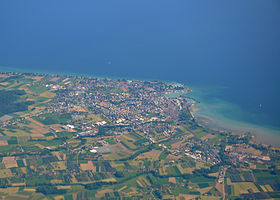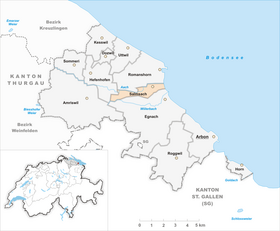Salmsach
| Salmsach | |
|---|---|
| State : |
|
| Canton : |
|
| District : | Arbon |
| BFS no. : | 4441 |
| Postal code : | 8599 |
| Coordinates : | 745 122 / 268 369 |
| Height : | 400 m above sea level M. |
| Height range : | 395–434 m above sea level M. |
| Area : | 2.71 km² |
| Residents: | 1457 (December 31, 2018) |
| Population density : | 538 inhabitants per km² |
| Website: | www.salmsach.ch |
|
Romanshorn (top) and Salmsach (bottom right) on an aerial photo from May 9, 2011 |
|
| Location of the municipality | |
Salmsach is a municipality and a town in the district of Arbon of the canton of Thurgau in Switzerland . Together with Egnach it belongs to the Amriswil - Romanshorn agglomeration . Until 2002 Salmsach was a unified municipality .
geography
Salmsach is located at the mouth of the Salmsacher Aach in Lake Constance . The community includes Salsmsach and the hamlets of Buerüüti (Buhreute), Fälwis (Fehlwies) and, since 1812, Hungerbüel and is located south of Romanshorn.
The municipal area corresponds roughly to a rectangular area with around 4 km west-east and an average of half a kilometer north-south. It borders the municipality of Romanshorn in the north, Lake Constance in the east, Egnach in the south and Hefenhofen in the west .
Although Salmsach does not have its own train station, the SBB lines Romanshorn – Winterthur , Romanshorn – Rorschach and the Südostbahn line run through the municipality.
history
Salmsach was originally related to the bishops of Constance . Bishop Solomon I is said to have founded a clerical community there, whose translation to St. Stephen in Constance Solomon III. ordered at 910. The fishing village formed around the chapel was first mentioned in 1159 as Salmasa . In 1155, the Konstanz Abbey in Salmsach had a courtyard, five barracks , the new fractional tenth and half of the church set, and around 1380 the judicial rights. The Saint Gallic abbot Ulrich Rösch acquired Salmsach and its church set in 1471 and combined it with the Romanshorn court . Until 1798 the monastery of St. Gallen held the team rights, the appellation and the homage . In 1803 the local parishes of Hemmerswil and Salmsach formed the municipality of Salmsach, in 1832 Hemmerswil separated again and in 1925 was incorporated into the local parish of Amriswil .
The knights to the churchyard of Arbon, who in 1201 had sealed a contract with the provost and chapter of St. Stephan on the appointment of a pastor, were co- collators . After the Reformation Salmsach was Protestant and the pastor of Salmsach held services in Romanshorn from 1588. In 1917 the union with the parish Romanshorn took place. In 1742 Hungerbüel and Salmsach founded a school.
In Salmsach, fruit, horticulture and arable farming predominated, and there were two mills until the 19th century. One factory produced Amylum around 1860 , another from 1878 to 1892 embroidery and from 1889 to 1931 a steam sawmill was in operation. In addition to trade, new industries emerged, including a. 1987 a plastics factory. While the hamlets kept their rural character, Salmsach became a residential community with a focus on Romanshorn. In 2005 the first business sector provided around 29% of jobs in the municipality.
Towards the end of the 20th century, the Salmsacher decided three times against a merger with the neighboring Romanshorn. On the occasion of the 700th anniversary of the Swiss Confederation in 1991, Salmsach celebrated its independence with the inauguration of its own community center. In November 2013, Salmsach's voters rejected a merger with the neighboring city again.
Say about the construction of the chapel
According to a legend, the building of the chapel in Salmsach should have taken place under strange circumstances:
- “Around 900 years ago, when Bishop Salomon traveled from Constance to St. Gallen, he was surprised by a bad storm. He wanted to take shelter under a large oak that was not far from him. Three farmers who had also sought protection from the storm had already fled under this tree. When he was only a few steps away from the oak, it was struck by lightning and the three farmers fatally killed. Thankful for his survival, Bishop Salomon von Konstanz had a small chapel built at this point. "
coat of arms
Blazon : In black, a yellow post flanked by two yellow bishop's staffs turned away .
The coat of arms indicates the place name as "Aach (waters) of Salomon", which is not tenable in terms of linguistic history .
population
 |
| year | 1850 | 1880 | 1900 | 1910 | 1941 | 1950 | 1960 | 1980 | 2000 | 2010 | 2018 |
| Residents | 419 | 418 | 719 | 875 | 743 | 812 | 889 | 1159 | 1326 | 1303 | 1443 |
Of the total of 1,443 inhabitants in the municipality of Salmsach in 2018, 396 or 27.4% were foreign nationals. The village of Salmsach had 1425 residents at that time.
economy
In 2016 Salmsach offered 325 people work (converted to full-time positions). Of these, 39.8% worked in agriculture and forestry, 22.8% in industry, trade and construction and 37.4% in the service sector.
Web links
Individual evidence
- ↑ Permanent and non-permanent resident population by year, canton, district, municipality, population type and gender (permanent resident population). In: bfs. admin.ch . Federal Statistical Office (FSO), August 31, 2019, accessed on December 22, 2019 .
- ↑ a b Thurgau in figures 2019 . On the website of the Statistical Office of the Canton of Thurgau (PDF file; 1.8 MB), accessed on April 28, 2020.
- ↑ a b Localities and their resident population. Edition 2019 . On the website of the Statistical Office of the Canton of Thurgau (Excel table; 0.1 MB), accessed on April 28, 2020.
- ^ The 50 agglomerations and 5 isolated cities of Switzerland on December 5th, 2000, on the website of the Federal Statistical Office
- ↑ a b c municipal coat of arms . On the website of the State Archives of the Canton of Thurgau, accessed on December 8, 2019
-
↑ a b c d e f Erich Trösch: Salmsach. In: Historical Lexicon of Switzerland .
These sections are largely based on the entry in the Historical Lexicon of Switzerland (HLS), which, according to the HLS's usage information, is under the Creative Commons license - Attribution - Share under the same conditions 4.0 International (CC BY-SA 4.0). - ↑ Church history. On the website of the Evangelical Parish Romanshorn-Salmsach, accessed on November 13, 2019
- ↑ Erich Trösch: Romanshorn. In: Historical Lexicon of Switzerland .
- ^ Verena Rothenbühler: Hemmerswil. In: Historical Lexicon of Switzerland .
- ↑ a b From the story of Salmsach. On the website of the Salmsach community, accessed on November 13, 2019
- ↑ Michèle Vaterlaus: The merger has failed. In: St. Galler Tagblatt (online) from November 25, 2013
- ↑ a b Population development of the municipalities. Canton Thurgau, 1850–2000 and resident population of the municipalities and change from the previous year. Canton of Thurgau, 1990–2018. On the website of the Statistical Office of the Canton of Thurgau (Excel tables; 0.1 MB each), accessed on April 28, 2020.





